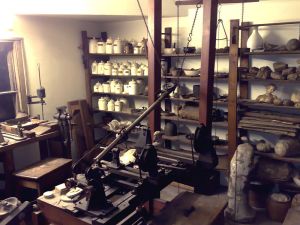RESPONSE #5 Katy Barrett
What makes an object whole? That’s the question with which I came away from our latest brilliant session with Simon Werrett. This came out in two different aspects of the session, which broadly connected back to Catherine Richardson’s by considering early modern science within the domestic space. We learnt how far and how ingeniously early modern natural philosophers recycled their instruments and ingredients, and how often these used domestic tools and spaces. By bringing along a microscope of his own, Simon got us to think about how, why and when an object is ‘broken.’ That’s one way in which the question of wholeness seemed key to the session.

The inside of James Watt’s garret workshop, preserved within the Science Museum, London (photograph by Frankie Roberto)
But what really struck me was a picture that Simon showed us of James Watt’s workshop table, now reconstructed, broken instruments and all, at the Science Museum. He used it to stress how natural philosophers like Watt used their domestic/working spaces to recycle objects and were made more creative by this process. It struck me as very like an artist’s studio, particularly like a number of studios that have also been reconstructed in museums: Francis Bacon’s at the Hugh Lane Gallery in Dublin or Eduardo Paolozzi’s at the National Galleries of Scotland. Both seem to emphasise creativity through accumulation of material and objects. I’ve always loved the fact that Bacon’s studio was deconstructed and analysed by a team of archaeologists in order to move it to Dublin. It was kept as a ‘whole’ object through this complex process.
Thinking about these studios and workshops made me think, further, about how my weather map printing plates are part of the Galton Collection: an extremely disparate set of objects brought together by being bequeathed to UCL by Galton or having come from his laboratory. So, it’s both person and place that unite these as a collection. My plates are linked to Liz’s lantern slides and also to Kate’s dog whistle. I need to find out more, if I can, about where my plates lived in Galton’s laboratory or house, and what other objects they were with. Presumably, as the first ever weather maps, they were carefully preserved from being broken or reused.
And that brings me back to the question of terminology that came up in the session. ‘Recycling’ is not an early-modern term. The ‘afterlife’ of objects is an alternative. But my plates’ life was, in that case, surely momentary? It was gone in the moment that the map was printed onto the final piece of newssheet. So is its life in the Galton Collection an afterlife or was the printing phase a pre-life?
